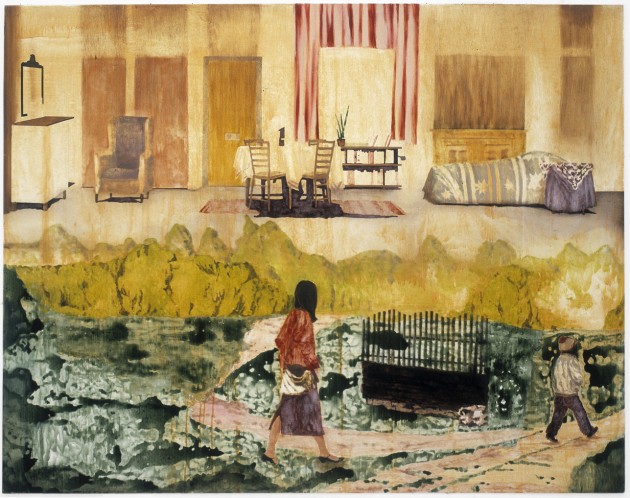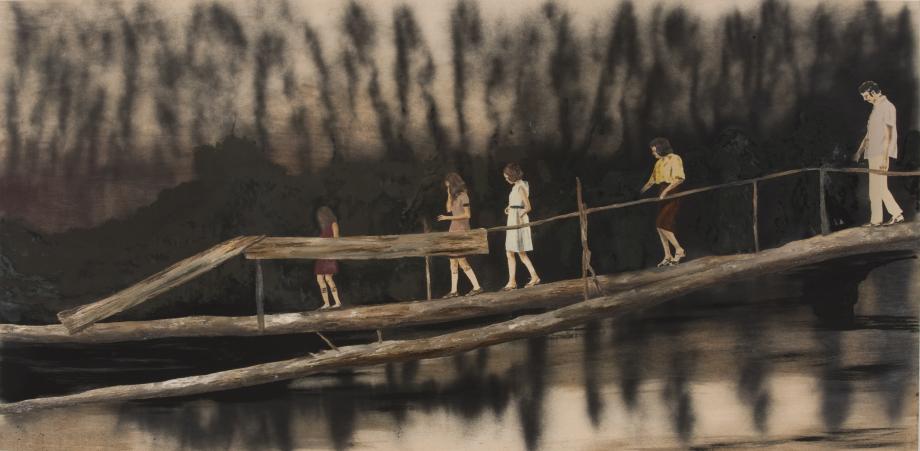“I think that poetry is the foundation of all artistic creation. It is the opposite of political and pragmatic thinking.”

Mamma Andersson, Coming Home, 2006. Oil and lacquer on panel 48 x 62 7/8 in. Courtesy David Zwirner, New York and Galleri Magnus Karlsson, Stockholm.
Karin Mamma Andersson is one of Scandinavia’s leading contemporary artists. In her paintings she pairs contemporary approaches to form and content with a specifically Nordic, romantic-expressive tradition. Her exhibit Dog Days is on view from February 23 – April 4, 2012 at Galleri Magnus Karlsson. Karin Mamma Andersson is represented by David Zwirner Gallery in New York and Galleri Magnus Karlsson in Sweden.
Jason Stopa: There is an everydayness to the images you create. But the longer one looks, the more mysterious they become. I think this especially true of the work in your latest exhibition Dog Days. Can you tell me about this recent body of work?
Mamma Andersson: Actually, it was the material itself that was the starting point for the series Dog Days. I stumbled over these dry blonde aspen panels. They were leftovers from an installation by another artist. The wood absorbed paint like a sponge, and I started to work on areas with dry, strong pigments and on other areas, thin and almost transparent.Image-wise, I knew that water — especially black water — time, and emptiness were topics that I wanted to work with. You mentioned everydayness. It is just daily life that interests me, all those days that just go on. It is in them that great events take place, right in front of us, but we hardly notice them. At its best, we understand afterwards what happened. It applies to love, degradation, persecution, actually everything. Suddenly, it is summer and we never noticed that spring passed.
JS: I like that. Events tend to happen suddenly, in-between a seemingly endless string of banality. One of the most striking things about this series are your titles. They are suggestive and enigmatic. Ramble On is one of my favorites. It captures the action but also a state of mind. Against the blackened background, the figures are descending to nowhere. There is a poetic quality about that image that I love. What role does poetic thought or narrative play in your work?
MA: I think that poetry is the foundation of all artistic creation. It is the opposite of political and pragmatic thinking. I read a lot of poetry; sometimes I borrow lines from poems. A title, in a remarkable way, can give a painting new dimensions. It creates further levels and makes it stronger. For me, as a Swede with very poor English grammar, it almost becomes a game when playing with English titles, which is both hopeless and challenging at the same time. A figurative painting can easily be interpreted as a story; actually, I’m more interested in setting a tone, a mood. A title can get viewers to see the painting in a different way. A series of paintings form a sort of history. I do not know how I feel about that. I often long for being abstract and quiet. I just don’t know how.
JS: I read the titles as non-literal. And the works definitely set a mood, but they are also mysterious. When I look at your paintings, they have a peculiar resonance, as if I have been there once before. What part does collective memory or dreams have in your work?
MA: Our collective memory is fascinating. Earlier today, I discussed this with a colleague who has for a long time been traveling with her art students to Berlin once a year. One year, several students did not really know what the Berlin Wall was. Before that year everyone had known. So it seems like not only the memory is collective.When I’m looking for image material as inspiration for my work, I understand how important it is for me that I feel a kind of identity with the images, in terms of time but also psychologically.It was very obvious when I was looking at photographs from different theatre productions. All set designs and costumes which were older than the 50s and 60s were rejected, but the settings from after the 90s felt too young and didn’t amuse me. I want to be a part of the image. If I am a part of the painting, then maybe some viewers can be too.
JS: This kind of subjective association allows viewers to enter the picture, and to some extent, inter-subjectivity. Formally, I like that your works are incredibly varied, employing thick marks up against faint sweeping gestures and intricate patterns. And it gets particularly exciting when there are transparent ghost images or black fissure-like forms. Do your images come together fluidly, within a sitting, or in parts?
MA: They all come in one sweep: it lasts, however, for a long time. One exhibition equals a sweep, a common mood. Each image goes through fire and water. Several paintings are in progress at the same time; they give each other energy. I can rest from a painting until I regain a good eye. The colors in the tubes, brushes, tapes, pigments, paint, sprays, solvents, crayons. I paint slowly, gently, thin, beautiful, ugly, thick, hard. I love it, it’s my life. But I hate it too. I am a painter, and I am always most focused on the actual painting. The other, the psyche, I just have to trust that I can keep up with — it is a quiet, messy, illogical confusing disorder. It is here that dreams and the subconscious come in.
























